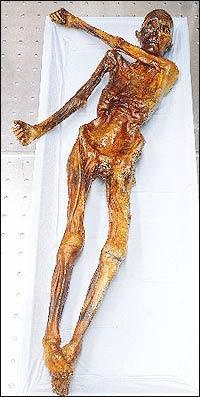But despite more than a decade of high-tech efforts by geneticists, botanists and engineers many questions about his life and death remain unsolved.

|
| ©South Tyrol Archaeology Museum |
| Archeologists believe the mummy may have been a shaman. |
And rumors of a deadly curse on those who found him continue to swirl.
German amateur mountaineer Helmut Simon and his wife spotted Oetzi, as he became known, in the mountains between Italy and Austria, near the Oetztal valley, in 1991.
At first glance, they thought it was the body of an unfortunate hiker.
Forensic medics and assistants also failed to recognize the significance of the find at first inspection: Documentary footage shows one assistant using a piece of wood, later identified as part of the mummy's ancient equipment, to unearth the frozen body.
Only recently have new methods such as DNA and tooth enamel analysis produced a clearer picture of his life.
"Looking at the iceman, we can see how science has developed over the past years," said Angelika Fleckinger, co-ordinator of the Museum of Archeology in the South Tyrolean city of Bolzano, where Oetzi is kept. "There are always new discoveries."
In the latest project, genetic researchers in Oxford and Bolzano are testing his DNA for clues about ethnicity.
Scientists expect the first results within months. The outcome could stir controversy in a region controversially claimed by Italians, German-speakers and members of the ancient Ladin culture.
"So far, we only know that he's a middle-European from earlier DNA tests," said Peter Pramstaller, leader of the team investigating the mummy's origins at Bolzano's Institute for Genetic Medicine.
"Through our new methods, we could learn more about his origin," he added.
STONE-AGE ACUPUNCTURE
Data from tooth enamel, soil and water samples has already shown that Oetzi probably grew up in the Pustertal region south of the Alps and left his home valley when he was 20 to 30 years old.
Archeologists believe he may have been a shaman. He used medicinal mushrooms, and his tattoos - a series of short, dark, parallel lines - had been placed to treat his arthritis as an early form of acupuncture.
But even the best scientists have been unable to explain the exact circumstances of his death.
In 2001, with the help of digital X-ray images, doctors detected an arrowhead in the iceman's shoulder blade.
DNA tests also revealed traces of blood from four different people on Oetzi's clothes, and a deep cut between his index finger and thumb, possibly from a fight.
The results have prompted a theory by Professor Walter Leitner at the University of Innsbruck, who has spent years studying the iceman, that Oetzi was probably victim of a political plot and assassinated by his own tribe.
Common criminals or members of an enemy tribe would have taken his extremely valuable possessions, such as a copper ax, generally carried by tribal leaders.
Oetzi was old for his time - at 45 - and this could mean that he was toppled by younger rivals, Leitner's theory goes.
"Of course, no one knows what it was really like," he said.
ICY CURSE
Science has also been unable to explain a series of sinister accidents since the iceman was discovered.
Forensic medic Rainer Henn, one of the first to touch the mummy, died in a car crash on his way to a lecture about Oetzi. A mountain guide who helped with the find plunged to his death, and a journalist who filmed the excavation died from cancer.
Last October, Helmut Simon fell to his death in the Alps after a sudden onset of bad weather near the spot where he had discovered Oetzi.
Walter Leitner was close to the scene the night Simon died.
At the time, he was explaining his iceman theory to a team of U.S. American journalists when they too were suddenly engulfed by the storm and had to be rescued by helicopter.
"At that moment I thought of my survival rather than the curse; of my family; my daughter's birthday the next day, and how I would maybe not be there," Leitner said.
"The next day, when I arrived at the institute, people were saying, 'Have you heard, Helmut Simon went missing in the mountains', and that's when I started feeling a bit queasy."
The archeologist explained Simon had been profoundly moved by his discovery, seeing it as a religious signal to convert to Christianity.
"But why should the mummy punish him for that?" Leitner added. "It doesn't make sense."



"The archeologist explained Simon had been profoundly moved by his discovery, seeing it as a religious signal to convert to Christianity.
"But why should the mummy punish him for that?" Leitner added. "It doesn't make sense.""
Oh yes it does! Let that be a lesson to everyone!